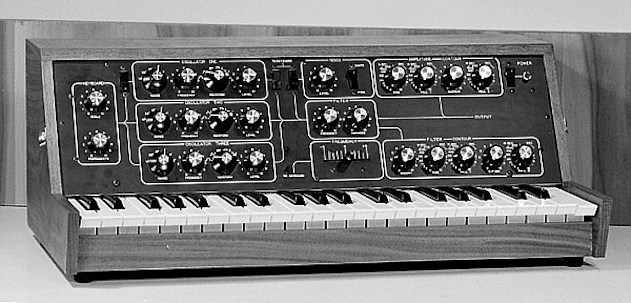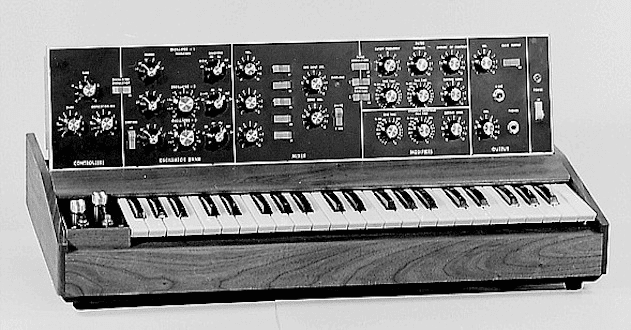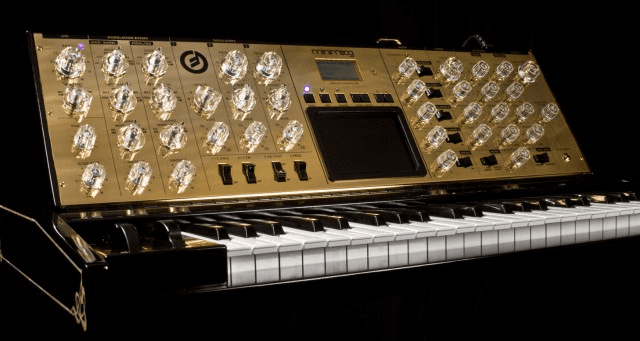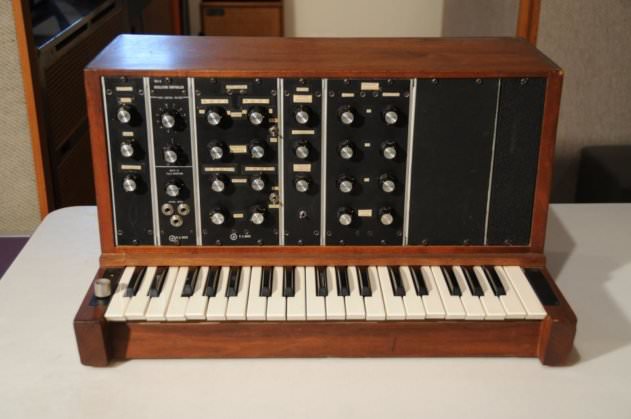Minimoog Models A, B and C
The ultimate prototypes
Estimated value: £20,000 each
It’s hardly contentious to argue that the legendary Minimoog is the most important synthesiser ever made. Many would go so far as to argue that it’s also the best. To give it its full title, the Minimoog Model D justifiably commands ever-higher prices on the second-hand market. But the name itself gives a clue as to the focus of our attention in this case. Only one variant of the Minimoog ever went on sale (albeit with occasional deviations from the standard formula), so why is it known as the ‘Model D’? The answer’s simple: the first three prototype Minimoogs were named models A, B and C.
These prototypes tell the story of the invention of the modern synthesiser as we know it. Before the Minimoog, ‘synthesiser’ was synonymous with modular synthesiser. Among Moog’s many contributions to music technology, the simplification of those gargantuan modular synths into a more portable, more affordable, more user-friendly form helped define what we now understand the synthesiser to be. Even now, 43 years on, the Minimoog is, whether consciously or subconsciously, the basic template upon which all synths are modelled, and the standard against which they’re judged.
Peter Kirn’s excellent feature on the Minimoog’s development, published by Keyboard magazine as part of the Minimoog’s 40th birthday celebrations in 2010, is essential reading for anyone with an interest in synth history. Moog engineer Bill Hemsath tells Kirn the story of the first Minimoog prototypes:
“‘One of my jobs was to demonstrate products to potential customers,’ says Hemsath. ‘We had a Model III – a large studio synthesizer with dozens of modules. Every time, I’d plug the oscillator into the filter and the filter into the VCA – probably six patch cords, total. It occurred to me after a month or two of this, what if I built a box that way?’
“With the need to replace the Moog modular racks with something portable, Robert Moog hired outside consultants to do drawings of what the case might look like. The resulting concepts were fitting for the Space Age. ‘They look like spaceships with curved backs – silly, but lovely,’ Hemsath recalls. ‘I think they did a dozen of those futuristic things. Down in the corner was this little, square wooden box with a flip-up lid.’
“As Bob Moog once recounted in Keyboard, a quick poll of musician friends revealed that they preferred the ‘natural wood and simple lines.’ Hemsath remembers a more practical reason: ‘Everybody said, “I can make that. I can build that.” So we threw out all the curved stuff, and Bob and I came in the next Saturday morning to the woodshop and just started sawing until we had that.'”
Over the course of the prototypes, Hemseth, Moog and their colleagues refined the design from a clumsy DIY effort based on Moog’s modules through to the iconic design which went on to redefine the meaning of ‘synthesiser’.

Minimoog Model B prototype

Minimoog Model C prototype
In terms of their position in history, the Minimoog prototypes are priceless. The importance of these testbeds cannot be overstated. In the event they come up for sale again, we’d expect the bidding to start at around £20,000.





07.09 AM
Fantastically thorough look into the value behind mouth-watering gearporn. Now time to start saving… ;-(
01.26 PM
Didn’t herbie hancock demo that Fairlight sampler on Sesame Street
01.30 PM
He certainly did, alongside a young Tatyana Ali (Ashley from The Fresh Prince Of Bel Air): http://www.youtube.com/watch?v=oKoisNv1ftw
This video of him showing it off to Quincy Jones is also excellent: http://www.youtube.com/watch?v=n6QsusDS_8A
02.35 PM
no Waldorf Wave?!
02.44 PM
The Wave’s definitely right up there with the best of them.
It’d be great to hear all your thoughts on this from a practical perspective too. As amazing as, say, a CS-80 is, would it necessarily be at the top of your shopping list if you won the lottery? We’ve got a feeling a lot of producers are probably more interested in slightly more affordable classics when it comes to actually making music…
12.09 PM
What about the GX1?
05.01 PM
I enjoyed this article as I continue to with Attack’s interviews and insightful cultural articles..
In addition to the vintage/analogue gear, I’d add some modern controllers to the list which have huge expressive capabilities not available on the mass market, such as polyphonic pitchbend and sensing on multiple axes. For example, the Haken Continuum is US$5,290 (without its case or stand). The newly-introduced ROLI Seaboard Grand is US$8,888.88. Those are the prices of decent used cars.
The CS-80 is an curious example of how performance controllers have regressed in some ways in the decades to come. How it takes something like an Arturia Origin (itself US$3,000) to include all those kinds of controllers. Not as much of a price delta change as you’d expect, given progress with home computers.
While some contemporary tech like touchscreens thrive (tablet market demand, thanks iPads!) and the DJ market has seen interesting plays (Maschine’s rise despite doubters re: the Akai dynasty), more specialized-to-music stuff languishes or is still available at very high prices. I figure there needs to be more popular education for new instruments to resolve part of this chicken-and-egg Gordian knot — otherwise most people, clinging onto the familiar piano form, are too scared to transition to it, keeping prices high.
02.44 PM
Great point, Torley. Things like the Continuum and Seaboard are very niche products, but to a certain type of performer or musician they’re truly desirable – partly because there aren’t many alternatives at any price point.
But you also hit on another interesting point. The touchscreen revolution led by the iPad virtually destroyed another product – JazzMutant’s Lemur controller, which eventually returned, slightly ironically, as an iOS app. And that trend for premium products to be replaced by cheaper alternatives is definitely mirrored in other markets – Maschine undercutting the MPCs, Moog introducing the Sub Phatty and dropping the Little Phatty, and so on (that’s without mentioning software, of course).
There really aren’t actually many super high-end synths around any more. There are products like the Prophet 12, SE CODE, Voyager XL, etc, but while the market for budget (<£500) and mid-range (£500-1000) synths seems to be thriving, anything larger is a much riskier proposition for any company.
Dave Smith acknowledged in our interview that the numbers today are much smaller, and that's despite the fact that synths are much cheaper in real terms than they were back in the 70s. Even with today's advances, the question of whether the market for a truly expressive, powerful performance-based synth in the vein of the CS-80 would still exist is open to debate.
03.17 PM
No GXs? No paper face Serge or Music Easel ? No Wave? No Fenix? And no Synthi 100?
12.54 PM
EMS?
05.01 AM
Wow! My CS-80’s “Slave to the Bass” video is posted here. (Blushes). It is a magnificent instrument. I used to sit in front of PBS Cosmos with Carl Sagan for a mind melding experience in the early 80’s after school. Our console TV had a good 6×9 speaker. Never expected to find a CS-80 of my own. I do not believe 2000 were ever made. So far, all functional CS-80’s are between serial numbers 1000-1800. It is believed that less than 800 were made. Cost prohibitive. There are 45 circuit boards, stuffed to the gills. Over 1200 internal trim pots to calibrate.
08.05 PM
https://www.youtube.com/watch?v=5esV1RiIB8o